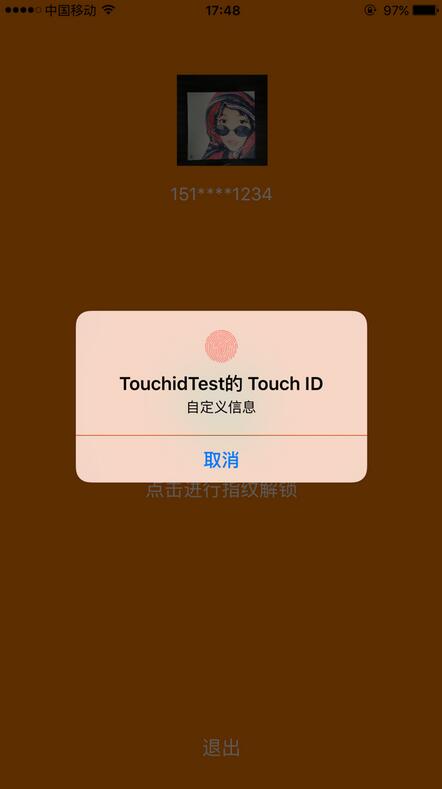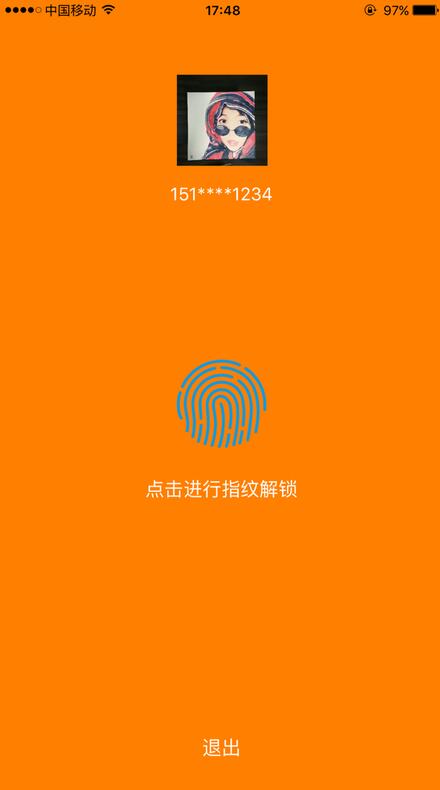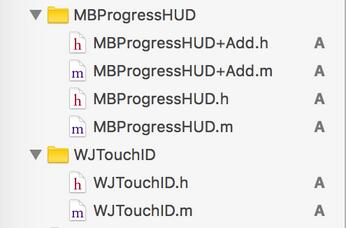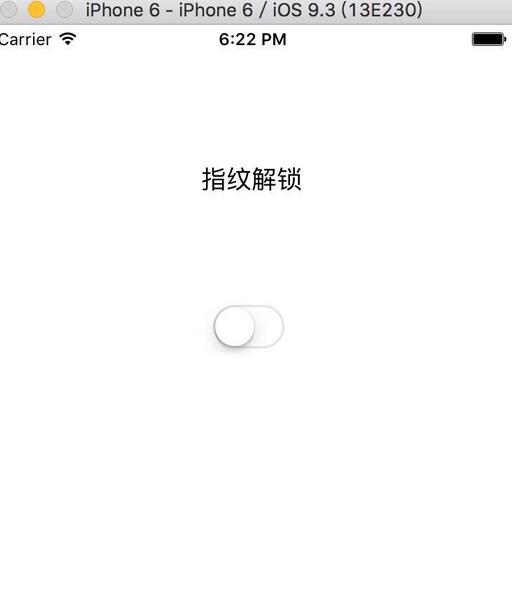- ubuntu12.04环境下使用kvm ioctl接口实现最简单的虚拟机
- Ubuntu 通过无线网络安装Ubuntu Server启动系统后连接无线网络的方法
- 在Ubuntu上搭建网桥的方法
- ubuntu 虚拟机上网方式及相关配置详解
CFSDN坚持开源创造价值,我们致力于搭建一个资源共享平台,让每一个IT人在这里找到属于你的精彩世界.
这篇CFSDN的博客文章iOS指纹验证TouchID应用学习教程2由作者收集整理,如果你对这篇文章有兴趣,记得点赞哟.
上一篇文章简单的写了对于touchid的简单了解。因为太懒了,就没有写实例,现在就单独写一篇应用吧,这篇想做的就是一个模仿那个叫啥软件来着,某某理财类类的软件的一个指纹验证解锁。我们做出来的页面应该如下图,在app挂起到后台的时候再点击到前台的时候回出现如下页面:
app唤醒的时候出现的画面 。

点击取消按钮出现的页面 。

这里我先挂上github的链接地址,毕竟本文的篇幅较长,也没什么人有耐心有时间看到最后,顶多看下demo,快速的知道怎么调用啥的就可以了。(popviewfortouchid) 。
因为我之前没遇到个这种情况,所以我做的都是自己瞎搞搞出来的,也不知道平时大家做的时候是怎么做的,就搞出来这样的,这里我打算用两种方法来实现,不过这个东西放进app中貌似是需要适配的。还是有些许问题的。可能要调下.
在app被唤醒的时候,出现页面我用了两种方式,一种是present出来一个单独的页面,一种方式是自定义弹出view.
但是本文呢,主要就介绍一下弹出式view的方式,因为present的方式跟这种方式差别就是在于一个是view一个是controller,主要的思想还是一样的.
第一部分 。
第一步 。
引入需要用的文件,以及创建pch文件,因为是小demo,所以一些宏定义直接丢进去就可以了.

第二步 。
创建pch文件,引入一些需要用到的文件以及宏定义,这里要是有问题的话可以参照我之前一篇文章写的引入pch文件,当然也可以老老实实的每个文件里都去引入头文件啥的,这个很随意的,毕竟是demo.
|
1
2
3
4
5
6
7
8
9
10
11
|
#import "appdelegate.h"
#import "wjtouchid.h"
#import "mbprogresshud.h"
#import "mbprogresshud+add.h"
// 屏幕bounds
#define ylsscreenbounds [uiscreen mainscreen].bounds
//位置
#define zlrect(x, y, w, h) cgrectmake([uiscreen mainscreen].bounds.size.width * x, [uiscreen mainscreen].bounds.size.height * y, [uiscreen mainscreen].bounds.size.width * w, [uiscreen mainscreen].bounds.size.height * h)
//字体大小
#define zcfont(f) [uiscreen mainscreen].bounds.size.width * f
|
第三步 。
实现基础页面,如下图 。

声明变量,遵守指纹验证控件的协议 。
|
1
2
3
4
5
6
7
|
@interface viewcontroller ()<wjtouchiddelegate>
/** noticelabel */
@property (nonatomic,strong) uilabel *label;
/** uiswitch */
@property (nonatomic,strong) uiswitch *touchidswitch;
@property (nonatomic, strong) wjtouchid *touchid;
@end
|
懒加载 。
|
1
2
3
4
5
6
7
8
|
-(uiswitch *)touchidswitch
{
if
(!_touchidswitch)
{
self.touchidswitch = [[uiswitch alloc]init];
}
return
_touchidswitch;
}
|
添加子控件 。
。
|
1
2
3
4
5
6
7
8
9
10
11
12
13
14
15
16
17
18
19
20
21
22
|
-(
void
)setsubviews
{
self.label = [[uilabel alloc]init];
[self.view addsubview:self.label];
[self.label setframe:zlrect(0, 100/667, 1, 20/667)];
[self.label settext:@
"指纹解锁"
];
[self.label settextalignment:nstextalignmentcenter];
[self.label setfont:[uifont systemfontofsize:zcfont(18/375)]];
self.touchidswitch = [[uiswitch alloc]init];
[self.touchidswitch setframe:zlrect(160/375, 200/667, 50/375, 28/667)];
[self.view addsubview:self.touchidswitch];
if
([[[nsuserdefaults standarduserdefaults]objectforkey:@
"touchid"
] isequaltostring:@
"1"
])
{
self.touchidswitch.on = yes;
}
else
{
self.touchidswitch.on = no;
}
[self.touchidswitch addtarget:self action:@selector(changeswitch:) forcontrolevents:uicontroleventvaluechanged];
}
|
这里要说一下 。
[[[nsuserdefaults standarduserdefaults]objectforkey:@"touchid"] isequaltostring:@"1"] 。
这个我是将是否设置了指纹验证存到了本地,因为当你进入设置页面的时候,必须知道你本机是否已经设置了指纹验证,这里存在着设置与未设置的一个页面ui差别,我这边就是用switch的开关来打开关闭指纹验证,也是用开关状态来表示指纹验证是否打开.
第四步 。
在viewdidload方法中调用设置子控件的方法,并且实现开关切换的方法.
|
1
2
3
4
|
- (
void
)viewdidload {
[super viewdidload];
[self setsubviews];
}
|
切换方法里呢,就是需要调用者会问验证,一般软件设置指纹验证的时候都会要求你先验证一下子,我在这里设置成只要你开或关闭都需要验证一下.
|
1
2
3
4
5
6
7
8
|
-(
void
)changeswitch:(id)sender
{
nslog(@
"------changeswitch-------"
);
wjtouchid *touchid = [[wjtouchid alloc]init];
[touchid startwjtouchidwithmessage:wjnotice(@
"自定义信息"
, @
"the custom message"
) fallbacktitle:wjnotice(@
""
, @
"fallback title"
) delegate:self];
self.touchid = touchid;
}
|
第五步 。
在上述调用指纹验证成功后,必须得实现它的回调函数,在成功或者失败的方法中写上你需要执行的代码.
。
|
1
2
3
4
5
6
7
8
9
10
11
12
13
14
15
16
17
18
19
20
21
22
23
24
25
26
27
28
29
30
31
32
33
34
35
36
37
38
39
40
41
42
43
44
45
46
47
48
49
50
51
52
53
54
55
56
57
58
59
60
61
62
63
64
65
66
67
68
69
70
71
72
73
74
75
76
77
78
79
80
81
82
83
84
85
|
//touchid验证成功
- (
void
) wjtouchidauthorizesuccess {
[[nsuserdefaults standarduserdefaults]setobject:@
"yes"
forkey:@
"touchidison"
];
if
(self.touchidswitch.on == yes)
{
[mbprogresshud showtext:@
"成功开启指纹解锁"
view:self.view];
[[nsuserdefaults standarduserdefaults] setobject:@
"1"
forkey:@
"touchid"
];
}
else
{
[mbprogresshud showtext:@
"指纹解锁关闭成功"
view:self.view];
[[nsuserdefaults standarduserdefaults] setobject:@
"0"
forkey:@
"touchid"
];
}
}
//touchid验证失败
- (
void
) wjtouchidauthorizefailure {
[[nsuserdefaults standarduserdefaults]setobject:@
"yes"
forkey:@
"touchidison"
];
if
(self.touchidswitch.on == yes){
self.touchidswitch.on = no;
[mbprogresshud showtext:@
"指纹解锁开启失败"
view:self.view];
[[nsuserdefaults standarduserdefaults] setobject:@
"0"
forkey:@
"touchid"
];
}
else
{
self.touchidswitch.on = yes;
[mbprogresshud showtext:@
"指纹解锁关闭失败"
view:self.view];
[[nsuserdefaults standarduserdefaults] setobject:@
"1"
forkey:@
"touchid"
];
}
}
//取消touchid验证 (用户点击了取消)
- (
void
) wjtouchidauthorizeerrorusercancel {
[[nsuserdefaults standarduserdefaults]setobject:@
"yes"
forkey:@
"touchidison"
];
if
(self.touchidswitch.on == yes){
self.touchidswitch.on = no;
[[nsuserdefaults standarduserdefaults] setobject:@
"0"
forkey:@
"touchid"
];
}
else
{
self.touchidswitch.on = yes;
[[nsuserdefaults standarduserdefaults] setobject:@
"1"
forkey:@
"touchid"
];
}
}
//在验证的touchid的过程中被系统取消 例如突然来电话、按了home键、锁屏
- (
void
) wjtouchidauthorizeerrorsystemcancel {
[[nsuserdefaults standarduserdefaults]setobject:@
"yes"
forkey:@
"touchidison"
];
if
(self.touchidswitch.on == yes){
self.touchidswitch.on = no;
[[nsuserdefaults standarduserdefaults] setobject:@
"0"
forkey:@
"touchid"
];
}
else
{
self.touchidswitch.on = yes;
[[nsuserdefaults standarduserdefaults] setobject:@
"1"
forkey:@
"touchid"
];
}
}
//多次连续使用touch id失败,touch id被锁,需要用户输入密码解锁
- (
void
) wjtouchidauthorizelaerrortouchidlockout {
[[nsuserdefaults standarduserdefaults]setobject:@
"yes"
forkey:@
"touchidison"
];
[mbprogresshud showtext:@
"验证失败"
view:self.view];
}
//当前软件被挂起取消了授权(如突然来了电话,应用进入前台)
- (
void
) wjtouchidauthorizelaerrorappcancel {
[[nsuserdefaults standarduserdefaults]setobject:@
"yes"
forkey:@
"touchidison"
];
if
(self.touchidswitch.on == yes){
self.touchidswitch.on = no;
[[nsuserdefaults standarduserdefaults] setobject:@
"0"
forkey:@
"touchid"
];
}
else
{
self.touchidswitch.on = yes;
[[nsuserdefaults standarduserdefaults] setobject:@
"1"
forkey:@
"touchid"
];
}
}
//当前软件被挂起取消了授权 (授权过程中,lacontext对象被释)
- (
void
) wjtouchidauthorizelaerrorinvalidcontext {
[[nsuserdefaults standarduserdefaults]setobject:@
"yes"
forkey:@
"touchidison"
];
if
(self.touchidswitch.on == yes){
self.touchidswitch.on = no;
[[nsuserdefaults standarduserdefaults] setobject:@
"0"
forkey:@
"touchid"
];
}
else
{
self.touchidswitch.on = yes;
[[nsuserdefaults standarduserdefaults] setobject:@
"1"
forkey:@
"touchid"
];
}
}
|
以上呢,我是没有判断是否支持touchid来写,是直接按照可以支持的来写的,大家在实际操作工程中还是需要加一下判断条件,因为现在还是有不支持touchid的机型的。然后就是要说一下下面这个.
[[nsuserdefaults standarduserdefaults]setobject:@"yes" forkey:@"touchidison"],
这个值我也不知道我是用来干嘛的,好像就是告诉我你设置了指纹验证了,然后在app唤醒的时候要根据一个值来判断是否需要调用指纹验证服务,我后来想了想,好像只要 。
[[[nsuserdefaults standarduserdefaults]objectforkey:@"touchid"] isequaltostring:@"1"] 。
这个就可以了,但是仔细想想还是再加上一个好分辨一点,毕竟就把一个当做判断switch是否打开,一个判断唤醒的时候要不要调用的吧。在不同的回调函数里面需要写的东西还是有差别的。这样上面写完之后,就等于实现一个简单的基础页面,当然这个还不是什么大问题,因为这个很简单,下面就是要实现弹出view了。篇幅好像有点长了,我自己看的也有点烦了都。。。。.
第二部分 。
第一步 。
创建自定义的view。在.h文件中写入方法 。
|
1
2
3
4
5
6
7
8
9
10
11
12
13
14
|
@interface ylstouchidview : uiview
/**
* 快速创建
*/
+(instancetype)touchidview;
/**
* 弹出
*/
-(
void
)show;
-(
void
)showinview:(uiview *)view;
@end
|
第二步 。
在.m文件中声明控件,设置页面大小,以及遵守协议,在页面出来的同时就要调用验证服务.
|
1
2
3
4
5
6
7
8
9
10
11
12
13
14
15
16
17
18
19
20
21
22
23
24
25
26
27
28
29
30
31
32
33
34
35
36
37
|
@interface ylstouchidview()<wjtouchiddelegate>
/** 指纹解锁的button */
@property (nonatomic,strong) uibutton *touchidbtn;
/** 头像 */
@property (nonatomic,strong) uiimageview *iconview;
/** 用户名 */
@property (nonatomic,strong) uilabel *namelabel;
/** 提示信息 */
@property (nonatomic,strong) uilabel *noticelabel;
/** 手机号 */
@property (nonatomic,strong) nsstring *phonenumber;
/** 退出按钮 */
@property (nonatomic,strong) uibutton *quitbtn;
@property (nonatomic, strong) wjtouchid *touchid;
@end
-(instancetype)initwithframe:(cgrect)frame
{
self = [super initwithframe:ylsscreenbounds];
if
(self)
{
self.backgroundcolor = [uicolor orangecolor];
}
//调用指纹解锁
wjtouchid *touchid = [[wjtouchid alloc]init];
[touchid startwjtouchidwithmessage:wjnotice(@
"自定义信息"
, @
"the custom message"
) fallbacktitle:wjnotice(@
""
, @
"fallback title"
) delegate:self];
self.touchid = touchid;
return
self;
}
|
第三步 。
设置控件的位置大小等等属性.
|
1
2
3
4
5
6
7
8
9
10
11
12
13
14
15
16
17
18
19
20
21
22
23
24
25
26
27
28
29
30
31
32
33
34
35
36
37
|
- (
void
)layoutsubviews
{
[super layoutsubviews];
self.iconview = [[uiimageview alloc]init];
[self.iconview setframe:zlrect(128/320, 54/568, 65/320, 65/568)];
[self.iconview setimage:[uiimage imagenamed:@
"icon_myinformation"
]];
[self addsubview:self.iconview];
self.namelabel = [[uilabel alloc]init];
[self.namelabel setframe:zlrect(0, 125/568, 1, 28/568)];
[self.namelabel settext:@
"151****1234"
];
[self.namelabel setfont:[uifont systemfontofsize:zcfont(15/375)]];
[self.namelabel settextcolor:[uicolor whitecolor]];
[self.namelabel settextalignment:nstextalignmentcenter];
[self addsubview:self.namelabel];
self.touchidbtn = [[uibutton alloc]init];
[self.touchidbtn setframe:zlrect(120/320, 250/568, 80/320, 80/568)];
[self.touchidbtn setimage:[uiimage imagenamed:@
"touchimg"
] forstate:uicontrolstatenormal];
[self.touchidbtn addtarget:self action:@selector(clicktochecktouchid) forcontrolevents:uicontroleventtouchupinside];
[self addsubview:self.touchidbtn];
self.noticelabel = [[uilabel alloc]init];
[self.noticelabel setframe:zlrect(0, 339/568, 1, 22/568)];
[self.noticelabel settext:@
"点击进行指纹解锁"
];
[self.noticelabel settextcolor:[uicolor whitecolor]];
[self.noticelabel settextalignment:nstextalignmentcenter];
[self.noticelabel setfont:[uifont systemfontofsize:zcfont(16/375)]];
[self addsubview:self.noticelabel];
self.quitbtn = [[uibutton alloc]init];
[self.quitbtn setframe:zlrect(0, 520/568, 1, 30/568)];
[self.quitbtn settitle:@
"退出"
forstate:uicontrolstatenormal];
[self.quitbtn addtarget:self action:@selector(quitcontent) forcontrolevents:uicontroleventtouchupinside];
[self addsubview:self.quitbtn];
}
|
第四步 。
实现控件的点击方法,以及在.h文件中声明的弹出方法 。
|
1
2
3
4
5
6
7
8
9
10
11
12
13
14
15
16
17
18
19
20
21
22
23
24
25
26
27
28
29
30
31
32
33
34
|
//快速创建
+ (instancetype)touchidview
{
return
[[self alloc]init];
}
/** 弹出 */
- (
void
)show
{
[self showinview:[uiapplication sharedapplication].keywindow];
}
- (
void
)showinview:(uiview *)view
{
// 浮现
[view addsubview:self];
}
-(
void
)clicktochecktouchid
{
nslog(@
"点击了指纹解锁"
);
[self.touchid startwjtouchidwithmessage:wjnotice(@
"自定义信息"
, @
"the custom message"
) fallbacktitle:wjnotice(@
""
, @
"fallback title"
) delegate:self];
}
-(
void
)quitcontent
{
nslog(@
"点击了quit"
);
[uiview animatewithduration:3 animations:^{
self.alpha = 0;
} completion:^(
bool
finished) {
[self removefromsuperview];
}];
}
|
上面再退出的时候我还加了一个小小的特效,就是颜色渐渐变成无色,这样有时候可以遮盖你app里面的一些小问题。偷个懒.
第五步 。
这里也是跟第一部分一样,实现验证的回调函数。这边的回调函数呢,跟之前的差不多,但是里面的内容就不一样了。而且我这里把不支持touchid的方法加进来,按理说这边是不需要加的,但是我前面没加进来,这里就硬塞进来吧。。。大家就凑合着看,自己用的时候可以直接删掉,不删掉也没事,就是增加点代码量而已。。.
。
|
1
2
3
4
5
6
7
8
9
10
11
12
13
14
15
16
17
18
19
20
21
22
23
24
25
26
27
28
29
30
31
32
33
34
35
36
37
38
39
40
41
42
43
44
45
46
47
48
49
50
51
52
53
54
55
56
57
58
59
60
61
62
63
64
65
66
67
68
69
70
71
72
73
74
75
76
77
78
|
/**
* touchid验证成功
*/
- (
void
) wjtouchidauthorizesuccess {
[mbprogresshud showtext:@
"解锁成功"
view:self];
[[nsuserdefaults standarduserdefaults]setobject:@
"yes"
forkey:@
"touchidison"
];
// [self dismissviewcontrolleranimated:yes completion:nil];
[self removefromsuperview];
}
/**
* touchid验证失败
*/
- (
void
) wjtouchidauthorizefailure {
[mbprogresshud showtext:@
"解锁失败"
view:self];
[[nsuserdefaults standarduserdefaults]setobject:@
"yes"
forkey:@
"touchidison"
];
}
/**
* 取消touchid验证 (用户点击了取消)
*/
- (
void
) wjtouchidauthorizeerrorusercancel {
[[nsuserdefaults standarduserdefaults]setobject:@
"yes"
forkey:@
"touchidison"
];
}
/**
* 在验证的touchid的过程中被系统取消 例如突然来电话、按了home键、锁屏...
*/
- (
void
) wjtouchidauthorizeerrorsystemcancel {
[[nsuserdefaults standarduserdefaults]setobject:@
"yes"
forkey:@
"touchidison"
];
}
/**
* 无法启用touchid,设备没有设置密码
*/
- (
void
) wjtouchidauthorizeerrorpasscodenotset {
[[nsuserdefaults standarduserdefaults]setobject:@
"yes"
forkey:@
"touchidison"
];
}
/**
* 设备没有录入touchid,无法启用touchid
*/
- (
void
) wjtouchidauthorizeerrortouchidnotenrolled {
[[nsuserdefaults standarduserdefaults]setobject:@
"yes"
forkey:@
"touchidison"
];
}
/**
* 该设备的touchid无效
*/
- (
void
) wjtouchidauthorizeerrortouchidnotavailable {
[[nsuserdefaults standarduserdefaults]setobject:@
"yes"
forkey:@
"touchidison"
];
}
/**
* 多次连续使用touch id失败,touch id被锁,需要用户输入密码解锁
*/
- (
void
) wjtouchidauthorizelaerrortouchidlockout {
[[nsuserdefaults standarduserdefaults]setobject:@
"yes"
forkey:@
"touchidison"
];
}
/**
* 当前软件被挂起取消了授权(如突然来了电话,应用进入前台)
*/
- (
void
) wjtouchidauthorizelaerrorappcancel {
[[nsuserdefaults standarduserdefaults]setobject:@
"yes"
forkey:@
"touchidison"
];
}
/**
* 当前软件被挂起取消了授权 (授权过程中,lacontext对象被释)
*/
- (
void
) wjtouchidauthorizelaerrorinvalidcontext {
[[nsuserdefaults standarduserdefaults]setobject:@
"yes"
forkey:@
"touchidison"
];
}
/**
* 当前设备不支持指纹识别
*/
-(
void
)wjtouchidisnotsupport {
[[nsuserdefaults standarduserdefaults]setobject:@
"yes"
forkey:@
"touchidison"
];
}
|
第三部分 。
这里呢,是最重要的地方,也是最简单的地方,只要在appdelegate.m文件中加上几句话就可以实现了。 在下面这个方法里面写,下面这个方法是呢app被唤醒进入活跃状态的方法 。
- (void)applicationdidbecomeactive:(uiapplication *)application 。
这边的知识点其实还挺多的,就是一个生命周期的问题,一个app运行完成,即将进入活跃状态,已经进入活跃状态,即将进入后台,已经进入后台状态,这几种状态,在之前我还想着声明一个变量让app在后台运行的时候,也跟着运行,类似于一个计时器,但是我看了网上的一些想要让app后台挂起的时候还能运行一些东西,设置过程就好几种,而且很多都说上架的时候审核是不给过得,想着有时间的话可以好好研究下那些方法,这里我就没有弄,所以才有了上面的 。
[[nsuserdefaults standarduserdefaults]setobject:@"yes" forkey:@"touchidison"],
这个值,本来也是设置成计时器的,但是这样好像更方便点,就这么设置了,因为为了全局都可以取到这个值。 在唤醒方法中写下代码 。
|
1
2
3
4
5
6
7
8
9
10
11
12
|
- (
void
)applicationdidbecomeactive:(uiapplication *)application {
nsstring *touchidexist = [[nsuserdefaults standarduserdefaults]objectforkey:@
"touchid"
];
nsstring *touchison = [[nsuserdefaults standarduserdefaults]objectforkey:@
"touchidison"
];
if
([touchidexist isequaltostring:@
"1"
] && [touchison isequaltostring:@
"no"
])
{
ylstouchidview *yls = [[ylstouchidview alloc]init];
[yls show];
}
dispatch_after(dispatch_time(dispatch_time_now, (int64_t)(20 * nsec_per_sec)), dispatch_get_main_queue(), ^{
[[nsuserdefaults standarduserdefaults]setobject:@
"no"
forkey:@
"touchidison"
];
});
}
|
下面那个呢就是为了防止重复调用,因为好像当页面出现指纹验证的弹出框的时候,app似乎就是被挂起到后台了,然后唤醒的时候又要被调用,所以这里出现了一个重复调用的问题,然后我就找个不是办法的办法来解决这个问题。就是用上面这段代码来处理,具体道理我也不知道咋说,就这么迷迷糊糊的实现了功能。这样子就是完成了一个指纹验证以及app唤醒的时候指纹解锁的一个小demo。present出来一个单独的页面的方式其实跟这个差不多,但是这篇文章的篇幅好像有点太长了,估计也没什么人看到最后,所以我就不写了,啥时候想补的话再补上来吧.
#### 还有就是,本人作为新手,上面代码有啥问题的话,或者有啥可以优化的地方,希望大家可以指正,大家一起共同进步共同学习.
以上就是本文的全部内容,希望对大家的学习有所帮助,也希望大家多多支持我.
最后此篇关于iOS指纹验证TouchID应用学习教程2的文章就讲到这里了,如果你想了解更多关于iOS指纹验证TouchID应用学习教程2的内容请搜索CFSDN的文章或继续浏览相关文章,希望大家以后支持我的博客! 。
关闭。这个问题是opinion-based .它目前不接受答案。 想要改进这个问题? 更新问题,以便 editing this post 可以用事实和引用来回答它. 关闭 9 年前。 Improve
介绍篇 什么是MiniApis? MiniApis的特点和优势 MiniApis的应用场景 环境搭建 系统要求 安装MiniApis 配置开发环境 基础概念 MiniApis架构概述
我正在从“JavaScript 圣经”一书中学习 javascript,但我遇到了一些困难。我试图理解这段代码: function checkIt(evt) { evt = (evt) ? e
package com.fastone.www.javademo.stringintern; /** * * String.intern()是一个Native方法, * 它的作用是:如果字
您会推荐哪些资源来学习 AppleScript。我使用具有 Objective-C 背景的传统 C/C++。 我也在寻找有关如何更好地开发和从脚本编辑器获取更快文档的技巧。示例提示是“查找要编写脚本的
关闭。这个问题不满足Stack Overflow guidelines .它目前不接受答案。 想改善这个问题吗?更新问题,使其成为 on-topic对于堆栈溢出。 4年前关闭。 Improve thi
关闭。这个问题不满足Stack Overflow guidelines .它目前不接受答案。 想改善这个问题吗?更新问题,使其成为 on-topic对于堆栈溢出。 7年前关闭。 Improve thi
关闭。这个问题不符合 Stack Overflow guidelines 。它目前不接受答案。 想改善这个问题吗?更新问题,以便堆栈溢出为 on-topic。 6年前关闭。 Improve this
我是塞内加尔的阿里。我今年60岁(也许这是我真正的问题-笑脸!!!)。 我正在学习Flutter和Dart。今天,我想使用给定数据模型的列表(它的名称是Mortalite,请参见下面的代码)。 我尝试
关闭。这个问题是off-topic .它目前不接受答案。 想改进这个问题? Update the question所以它是on-topic对于堆栈溢出。 9年前关闭。 Improve this que
学习 Cappuccino 的最佳来源是什么?我从事“传统”网络开发,但我对这个新框架非常感兴趣。请注意,我对 Objective-C 毫无了解。 最佳答案 如上所述,该网站是一个好地方,但还有一些其
我正在学习如何使用 hashMap,有人可以检查我编写的这段代码并告诉我它是否正确吗?这个想法是有一个在公司工作的员工列表,我想从 hashMap 添加和删除员工。 public class Staf
我正在尝试将 jQuery 与 CoffeScript 一起使用。我按照博客中的说明操作,指示使用 $ -> 或 jQuery -> 而不是 .ready() 。我玩了一下代码,但我似乎无法理解我出错
还在学习,还有很多问题,所以这里有一些。我正在进行 javascript -> PHP 转换,并希望确保这些做法是正确的。是$dailyparams->$calories = $calories;一条
我目前正在学习 SQL,以便从我们的 Magento 数据库制作一个简单的 RFM 报告,我目前可以通过导出两个查询并将它们粘贴到 Excel 模板中来完成此操作,我想摆脱 Excel 模板。 我认为
我知道我很可能会因为这个问题而受到抨击,但没有人问,我求助于你。这是否是一个正确的 javascript > php 转换 - 在我开始不良做法之前,我想知道这是否是解决此问题的正确方法。 JavaS
除了 Ruby-Doc 之外,哪些来源最适合获取一些示例和教程,尤其是关于 Ruby 中的 Tk/Tile?我发现自己更正常了 http://www.tutorialspoint.com/ruby/r
我只在第一次收到警告。这正常吗? >>> cv=LassoCV(cv=10).fit(x,y) C:\Python27\lib\site-packages\scikit_learn-0.14.1-py
按照目前的情况,这个问题不适合我们的问答形式。我们希望答案得到事实、引用或专业知识的支持,但这个问题可能会引发辩论、争论、投票或扩展讨论。如果您觉得这个问题可以改进并可能重新打开,visit the
As it currently stands, this question is not a good fit for our Q&A format. We expect answers to be

我是一名优秀的程序员,十分优秀!